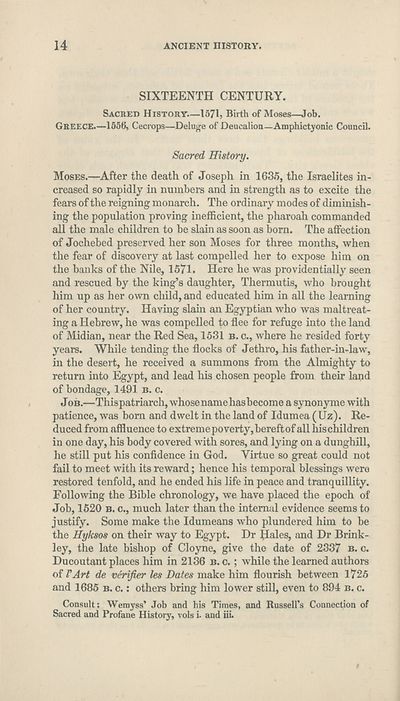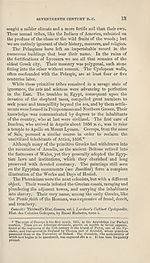Download files
Complete book:
Individual page:
Thumbnail gallery: Grid view | List view

14
ANCIENT HISTORY.
SIXTEENTH CENTURY.
Sacred History.—1571, Birth of Moses—Job.
Greece.—1556, Cecrops—Deluge of Deucalion—Amphictyonic Council.
Sacred History.
Moses.—After the death of Joseph in 1635, the Israelites in¬
creased so rapidly in numbers and in strength as to excite the
fears of the reigning monarch. The ordinary modes of diminish¬
ing the population proving inefficient, the pharoah commanded
all the male children to be slain as soon as born. The affection
of Jochebed preserved her son Moses for three months, when
the fear of discovery at last compelled her to expose him on
the banks of the Nile, 1571. Here he was providentially seen
and rescued by the king’s daughter, Thermutis, who brought
him up as her own child, and educated him in all the learning
of her country. Having slain an Egyptian who was maltreat¬
ing a Hebrew, he was compelled to flee for refuge into the land
of Midian, near the Red Sea, 1531 b. c., where he resided forty
years. While tending the flocks of Jethro, his father-in-law,
in the desert, he received a summons from the Almighty to
return into Egypt, and lead his chosen people from their land
of bondage, 1491 b. c.
Job.—Thispatriarch, whose namehasbecome a synonyme with
patience, was born and dwelt in the land of Idumea (Uz). Re¬
duced from affluence to extreme poverty,bereftof all hischildren
in one day, his body covered with sores, and lying on a dunghill,
he still put his confidence in God. Virtue so great could not
fail to meet with its reward; hence his temporal blessings were
restored tenfold, and he ended his life in peace and tranquillity.
Following the Bible chronology, we have placed the epoch of
Job, 1520 b. c., much later than the internal evidence seems to
justify. Some make the Idumeans who plundered him to be
the Hyksos on their way to Egypt. Dr Hales, and Dr Brink-
ley, the late bishop of Cloyne, give the date of 2337 b. c.
Ducoutant places him in 2136 b. c. ; while the learned authors
of PArt de verifier les Dates make him flourish between 1725
and 1685 b. c. : others bring him lower still, even to 894 b. c.
Consult: Wemyss’ Job and his Times, and Russell’s Connection of
Sacred and Profane History, vols i. and iii.
ANCIENT HISTORY.
SIXTEENTH CENTURY.
Sacred History.—1571, Birth of Moses—Job.
Greece.—1556, Cecrops—Deluge of Deucalion—Amphictyonic Council.
Sacred History.
Moses.—After the death of Joseph in 1635, the Israelites in¬
creased so rapidly in numbers and in strength as to excite the
fears of the reigning monarch. The ordinary modes of diminish¬
ing the population proving inefficient, the pharoah commanded
all the male children to be slain as soon as born. The affection
of Jochebed preserved her son Moses for three months, when
the fear of discovery at last compelled her to expose him on
the banks of the Nile, 1571. Here he was providentially seen
and rescued by the king’s daughter, Thermutis, who brought
him up as her own child, and educated him in all the learning
of her country. Having slain an Egyptian who was maltreat¬
ing a Hebrew, he was compelled to flee for refuge into the land
of Midian, near the Red Sea, 1531 b. c., where he resided forty
years. While tending the flocks of Jethro, his father-in-law,
in the desert, he received a summons from the Almighty to
return into Egypt, and lead his chosen people from their land
of bondage, 1491 b. c.
Job.—Thispatriarch, whose namehasbecome a synonyme with
patience, was born and dwelt in the land of Idumea (Uz). Re¬
duced from affluence to extreme poverty,bereftof all hischildren
in one day, his body covered with sores, and lying on a dunghill,
he still put his confidence in God. Virtue so great could not
fail to meet with its reward; hence his temporal blessings were
restored tenfold, and he ended his life in peace and tranquillity.
Following the Bible chronology, we have placed the epoch of
Job, 1520 b. c., much later than the internal evidence seems to
justify. Some make the Idumeans who plundered him to be
the Hyksos on their way to Egypt. Dr Hales, and Dr Brink-
ley, the late bishop of Cloyne, give the date of 2337 b. c.
Ducoutant places him in 2136 b. c. ; while the learned authors
of PArt de verifier les Dates make him flourish between 1725
and 1685 b. c. : others bring him lower still, even to 894 b. c.
Consult: Wemyss’ Job and his Times, and Russell’s Connection of
Sacred and Profane History, vols i. and iii.
Set display mode to:
![]() Universal Viewer |
Universal Viewer | ![]() Mirador |
Large image | Transcription
Mirador |
Large image | Transcription
| Antiquarian books of Scotland > Education > Elements of universal history on a new and systematic plan > (34) |
|---|
| Permanent URL | https://digital.nls.uk/127580548 |
|---|
| Description | Thousands of printed books from the Antiquarian Books of Scotland collection which dates from 1641 to the 1980s. The collection consists of 14,800 books which were published in Scotland or have a Scottish connection, e.g. through the author, printer or owner. Subjects covered include sport, education, diseases, adventure, occupations, Jacobites, politics and religion. Among the 29 languages represented are English, Gaelic, Italian, French, Russian and Swedish. |
|---|

